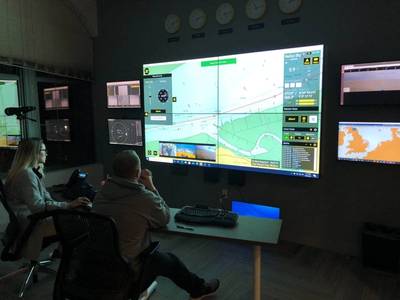Maritime Trade Union Signs on Sea Machines' Autonomous Voyage Project
U.S. Coast Guard licensed officers in Boston are commanding an autonomous workboat on a voyage around Denmark.
The American Maritime Officers (AMO) trade union has entered into a labor agreement with autonomous command and control systems developer Sea Machines Robotics for the project, which will see AMO-represented merchant mariners support Sea Machines’ first-of-its-kind 1,000 NM autonomous journey.
The voyage, which Sea Machines is calling "The Machine Odyssey", aims to prove the world’s waterways are primed and ready for long-range autonomous vessel operations, while the partnership between AMO and Sea Machines signals the recognition of a relationship among workers, technology and business in the evolving maritime sector.
AMO officers in Sea Machines’ Boston-based control center will remotely command the Damen-built workboat Nellie Bly on her autonomous voyage. The officers received training prior to the voyage kick-off and have support from the Sea Machines’ engineering teams in Boston and Hamburg throughout the estimated three-week program. Additionally, the Nellie Bly will always carry two on-board safety captains, with occasional guest passengers, and will call on ports along the route to display and demonstrate the technology.
AMO is taking the strategic step to ensure the merchant marine officers it represents can continue to have a secure role in an evolving industry as new technology is developed and applied, said AMO National Executive Vice President Captain William Barrere.
"AMO is working to anticipate and prepare for the future of the maritime industry, understanding the implementation of the technology will happen in the not-so-distant future," he said. "Failure to prepare for the future means failure to participate in it. Through this agreement, AMO is working to set careers for future generations of merchant mariners.
"AMO is committed to ensuring the human element—particularly the expertise of U.S. merchant mariners earned through extensive experience and comprehensive training at industry-leading facilities, such as STAR Center—remains a key component of maritime transportation to ensure safe navigation, sustained mariner employment and the reliable operation of onboard equipment and systems."
Sea Machines said it shares AMO's goal of ensuring the safe and effective operation of vessels as increasing levels of automation continue to be applied throughout the maritime industry. The company said it has always aimed to create technologies that provide new operational methodologies, increase operational productivity and predictability and increase at-sea safety for mariners.
“Sea Machines is built by a team of mariners—currently employing from five of the seven U.S. maritime academies—and operates with a mission to uplift and expand marine industries with technology,” said Sea Machines’ CEO Michael Johnson. “We envision a future in which autonomous technology can expand the world’s fleets and waterborne transportation systems, make transport over water more versatile and competitive with other modes of transportation, and expand the maritime workforce through growth in the industry, ultimately creating jobs.”


















